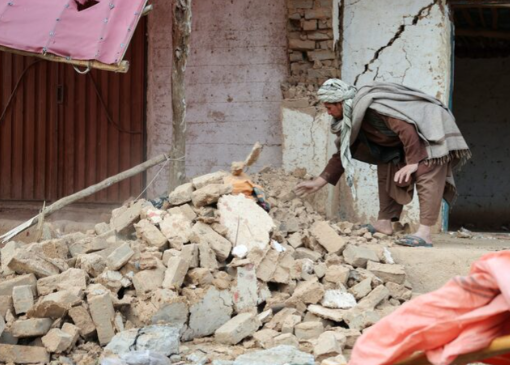The United Nations pledged emergency aid for Afghanistan, joined by India and China, while experts urge earthquake-resistant rebuilding due to poor construction standards
TANGI TASHQURGHAN
Residents in northern Afghanistan have begun clearing debris after a strong 6.3 magnitude earthquake killed at least 20 people and injured nearly 1,000 others.
The quake struck early Monday near Mazar-i-Sharif, damaging hundreds of homes and even the city’s famous Blue Mosque.
Authorities said about 945 people were hurt, with many suffering from building collapses and falling debris. The Afghanistan National Disaster Management Authority reported that hundreds of houses were destroyed or badly damaged—raising fears as freezing winter weather approaches.
On Tuesday, villagers in Tangi Tashqurghan, near the quake’s epicentre, worked to dig through rubble and strengthen unstable buildings. Local shopkeeper Mohammad Yasin said dozens of stores were left unsafe. “If you go inside, you feel afraid they might collapse at any moment,” he said.
The quake adds to Afghanistan’s growing list of crises under the Taliban government, which is already struggling with reduced foreign aid, refugee returns, and rebuilding after earlier disasters. In August, another powerful quake killed thousands in the eastern provinces.
The United Nations has pledged emergency aid, joined by India and China, which both promised humanitarian support. Experts say Afghanistan’s frequent earthquakes are worsened by poor construction standards, urging stronger, earthquake-resistant designs for future rebuilding.
Afghanistan, surrounded by rugged mountains and active fault lines, records an average of 560 earthquake-related deaths each year. With limited resources and fragile infrastructure, the country faces a tough recovery as winter sets in.
BOX
Why is Afghan prone to earthquakes?
- The country is located on the edge of the Eurasian tectonic plate, which shares a transgression zone with the Indian plate, implying the two may converge or brush past each other, and is also influenced by the Arabian plate to its south, creating one of the world’s most tectonically active regions.
- The northward movement of the Indian plate and its thrust against the Eurasian plate is usually responsible for Afghanistan’s numerous quakes.
Vulnerable areas
- Afghanistan, surrounded by rugged mountains and active fault lines, records an average of 560 earthquake-related deaths each year
- Eastern and northeastern Afghanistan, especially regions along its borders with Uzbekistan, Tajikistan, and Pakistan, are particularly prone to earthquakes.
- Last night’s earthquake caused loss of life and property in Balkh, Samangan, and Baghlan provinces



